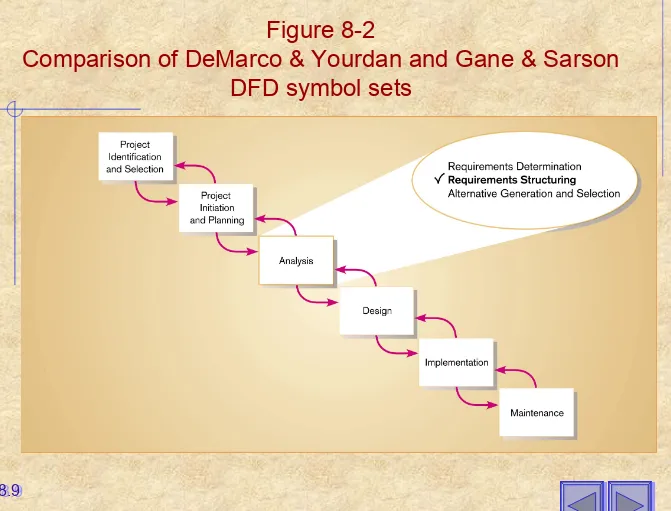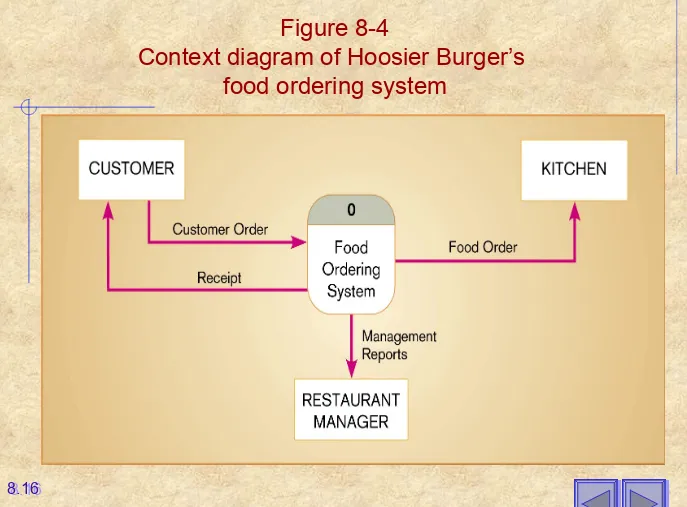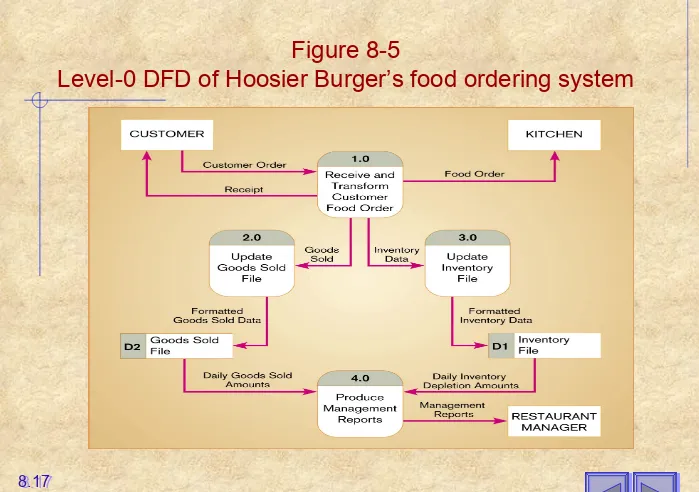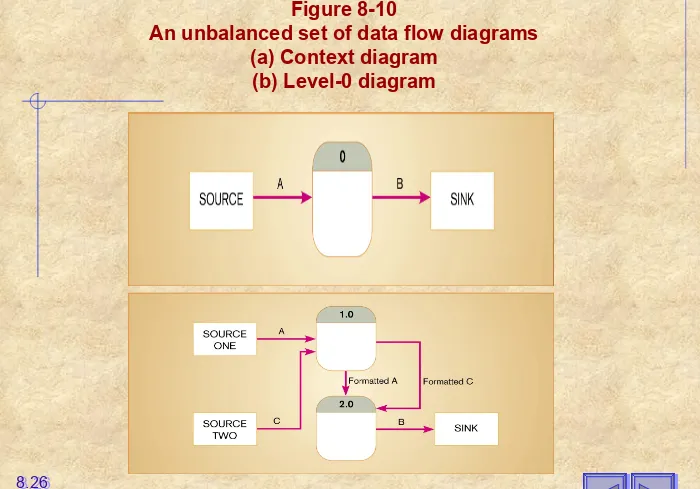Modern Systems Analysis
and Design
Third Edition
Jeffrey A. Hoffer Joey F. George Joseph S. Valacich
Chapter 8
Structuring System
Requirements:
Learning Objectives
Understand the logical modeling of
processes through studying data flow
diagrams
How to draw data flow diagrams using
rules and guidelines
How to decompose data flow diagrams
into lower-level diagrams
Learning Objectives
Explain the differences among four types of DFDs: current physical, current logical, new physical and new logical
Discuss the use of data flow diagrams as analysis tools
Compare and contrast data flow diagrams with Oracle’s process modeling tool and withfunctional hierarchy diagrams
Process Modeling
Graphically represent the processes
that capture, manipulate, store and
distribute data between a system and its
environment and among system
components
Data flow diagrams (DFD)
Graphically illustrate movement of data
between external entities and the
Process Modeling
Modeling a system’s process
Utilize information gathered during
requirements determination
Structure of the data is also modeled in
addition to the processes
Deliverables and Outcomes
Set of coherent, interrelated data flow
Process Modeling
Deliverables and outcomes (continued)
Context data flow diagram (DFD)
Scope of system
DFDs of current system
Enables analysts to understand current system
DFDs of new logical system
Technology independent
Show data flows, structure and functional
Process Modeling
Deliverables and outcomes (continued)
Data Flow Diagramming
Mechanics
Four symbols are used
See Figure 8-2
Two different standard sets can be used
Figure 8-2
Data Flow Diagramming
Mechanics
Data Flow
Depicts data that are in motion and moving
as a unit from one place to another in the system.
Drawn as an arrow
Select a meaningful name to represent the
Data Flow Diagramming
Mechanics
Data Store
Depicts data at rest May represent data in
File folder
Computer-based file Notebook
The name of the store as well as the
Data Flow Diagramming
Mechanics
Process
Depicts work or action performed on data
so that they are transformed, stored or distributed
Number of process as well as name are
Data Flow Diagramming
Mechanics
Source/Sink
Depicts the origin and/or destination of the
data
Sometimes referred to as an external entity Drawn as a square symbol
Name states what the external agent is Because they are external, many
Data Flow Diagramming
Definitions
Context Diagram
A data flow diagram (DFD) of the scope of an
organizational system that shows the system
boundaries, external entities that interact with the system and the major information flows between the entities and the system
Level-O Diagram
A data flow diagram (DFD) that represents a
Developing DFDs: An
Example
Hoosier Burger’s automated food
ordering system
Context Diagram (Figure 8-4) contains
no data stores
Figure 8-4
Figure 8-5
Data Flow Diagramming Rules
Basic rules that apply to all DFDs
Inputs to a process are always different
than outputs
Objects always have a unique name
Data Flow Diagramming Rules
Process
No process can have
only outputs (a miracle)
No process can have
only inputs (black hole)
A process has a verb
phrase label
Data Store
Data cannot be moved
directly from one store to another
Data cannot move
directly from an outside source to a data store
Data cannot move
directly from a data store to a data sink
Data Flow Diagramming Rules
Source/Sink
Data cannot move
directly from a source to a sink
A source/sink has a
noun phrase label
Data Flow
A data flow has only one
direction of flow between symbols
A fork means that exactly
Data Flow Diagramming Rules
Data Flow (Continued)
L. A join means that exactly the same data comes
from any two or more different processes, data stores or sources/sinks to a common location
M. A data flow cannot go directly back to the same
process it leaves
N. A data flow to a data store means update
O. A data flow from a data store means retrieve or
use
Decomposition of DFDs
Functional decomposition
Act of going from one single system to many
component processes
Repetitive procedure
Lowest level is called a primitive DFD
Level-N Diagrams
A DFD that is the result of n nested
Balancing DFDs
When decomposing a DFD, you must conserve inputs to and outputs from a process at the next level of decomposition
This is called balancing
Example: Hoosier Burgers
In Figure 8-4, notice that there is one input to the
system, the customer order
Three outputs:
Customer receipt
Balancing DFDs
Example (Continued)
Notice Figure 8-5. We have the same
inputs and outputs
No new inputs or outputs have been
introduced
We can say that the context diagram and
Balancing DFDs
An unbalanced example
Figure 8-10
In context diagram, we have one input to
the system, A and one output, B
Level-0 diagram has one additional data
flow, C
Figure 8-10
An unbalanced set of data flow diagrams (a) Context diagram
Balancing DFDs
We can split a data flow into separate
data flows on a lower level diagram (see
Figure 8-11)
Four Different Types of DFDS
Current Physical
Process label includes an identification of
the technology (people or systems) used to process the data
Data flows and data stores are labeled with
Four Different Types of DFDS
Current Logical
Physical aspects of system are removed as much
as possible
Current system is reduced to data and processes
that transform them
New Logical
Includes additional functions
Obsolete functions are removed
Four Different Types of DFDS
New Physical
Represents the physical implementation of
Guidelines for Drawing DFDs
Completeness
DFD must include all components
necessary for system
Each component must be fully described in
the project dictionary or CASE repository
Consistency
The extent to which information contained
Guidelines for Drawing DFDs
Timing
Time is not represented well on DFDs Best to draw DFDs as if the system has
never started and will never stop.
Iterative Development
Analyst should expect to redraw diagram
several times before reaching the closest approximation to the system being
Guidelines for Drawing DFDs
Primitive DFDs
Lowest logical level of decomposition Decision has to be made when to stop
Guidelines for Drawing DFDs
Rules for stopping decomposition
When each process has been reduced to a
single decision, calculation or database operation
When each data store represents data
about a single entity
When the system user does not care to
Guidelines for Drawing DFDs
Rules for stopping decomposition (continued)
When every data flow does not need to be split
further to show that data are handled in various ways
When you believe that you have shown each
business form or transaction, on-line display and report as a single data flow
When you believe that there is a separate process
Using DFDs as Analysis Tools
Gap Analysis
The process of discovering discrepancies
between two or more sets of data flow
diagrams or discrepancies within a single DFD
Using DFDs in Business
Process Reengineering
Example: IBM Credit
See Figure 8-20 – before reengineering Credit approval process required six days
before BPR
Figure 8-21 depicts DFD after
reengineering
IBM was able to process 100 times the
Oracle’s Process Modeler and
Functional Hierarchy Diagrams
Process Modeler
Unique to Oracle
Similar to DFDS but outputs and methods differ in
several ways.
Table 8-4 illustrates differences
Functional Hierarchy Diagrams
Picture of various tasks performed in a business
and how they are related
Tasks are broken down into their various parts
Summary
Data flow diagrams (DFD)
Symbols
Rules for creating
Decomposition
Balancing
Four different kinds of DFDs
Current Physical
Current Logical




